
The discovery of vast quantities of high quality Etruria Marl clay in the Ruabon area in the 19th Century heralded the beginning of tile and terracotta production on a vast scale. By the turn of the 20th Century, several factories employed roughly 2,000 people. Workers produced massive amounts of terracotta, earning the village of Ruabon the nickname Terracottapolis. But it was for the distinctive red bricks that the area became famous. The material was so popular it was used to build schools, hospitals, universities, law courts, pubs and other key buildings in cities across the country.

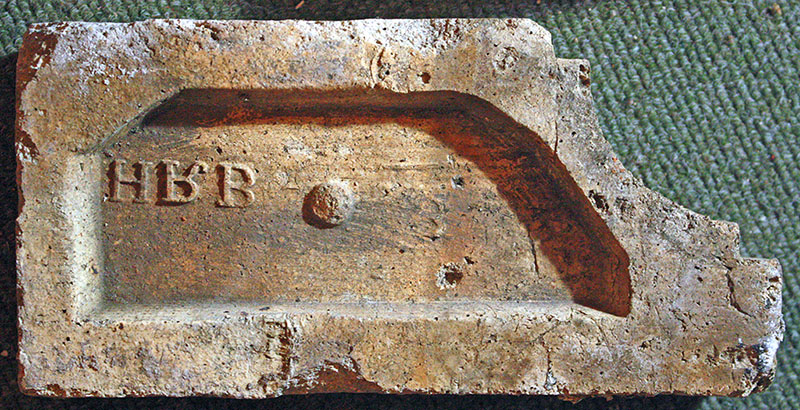


Photos by David Kitching.

Henry R Bowers Ltd. The "Tatham Brick & Tile Works" or "Afongoch & Tatham Tileries" - at Afongoch, on the west side of the Ruabon-Wrexham road, off Tatham Road. Henry Bowers was operating from this site by 1854 producing glazed stoneware pipes, firebricks and white facing bricks. The business flourished until his death in 1902 but then declined and was liquidated in 1912. The brickworks site was quarried away by Rhos Fireclays Ltd in the 1970s. Photo by Frank Lawson.
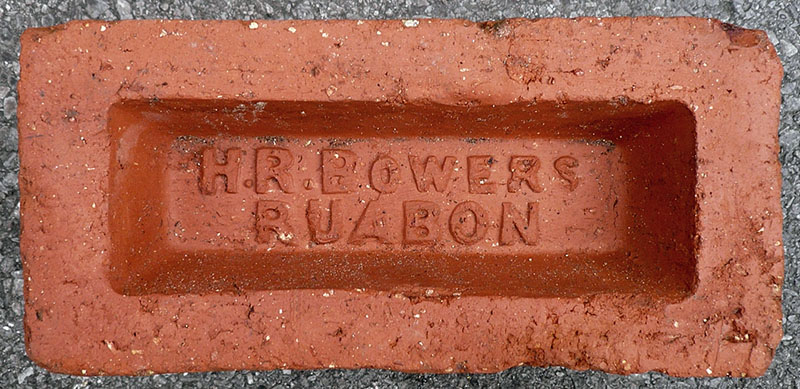
Photo by Alan Davies.

T W Cowan, Cambrian brickworks, Acrefair, Ruabon. The first lease of the coal and fireclay to Mr Cowan was in 1865 and in 1866 he advertised his "Trefynant Colliery & Fireclay Works" as supplying bricks, ridge tiles, chimney tops etc. Soon after the works was offered for sale and by 1874 the lease had been transferred to a John Jackson. Photo by David Kitching.

Photo by Ian Williams.
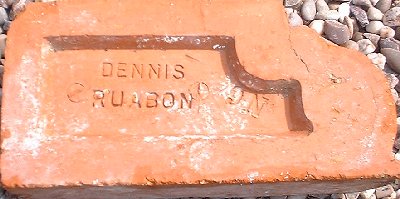


The most famous of the industrialists in Wrexham in the late 19th Century was Henry Dennis, who founded the company in 1878 that would later become Dennis Ruabon Tiles Ltd. Dennis, born in Bodmin, Cornwall, studied civil engineering and travelled to Wales to supervise construction of a tramway at a slate quarry near Llangollen. After a stint in Spain at a lead mine, he later returned to Wales after amassing a considerable personal fortune. Dennis became managing director of the Hafod Colliery and by 1878, had established the Hafod Brickworks. By 1893, a new factory which became known as the "Red Works", was constructed on the site where the present-day building still stands. There, workers produced ridge tiles, chimney pots, tiles and other products using 24 coal-fired "Beehive" kilns.The business flourished at a time when demand for the red bricks and terracotta was high. By the time of his death in 1906, Dennis had established himself as a giant of the industry, ensuring that his firm - and the name of Ruabon - had been forever cemented in British architectural history. He also had interests in collieries, lead mines and water and gas, and is thought to have employed up to 10,000 people. Under the control of his son, Henry Dyke Dennis, the Hafod brickworks became a private limited company in 1934 - Dennis Ruabon Limited - and continued to produce materials including tiles, chimney pots and ornamental terracotta. In 1944, Dennis's grandson, Patrick Gill Dyke Dennis, took control and launched a modernisation programme. By the end of the 1970s, brick production had largely ended, and the company concentrated its efforts on making quarry tiles.


Photos by David Kitching.

Photo by Kate Bowdon.
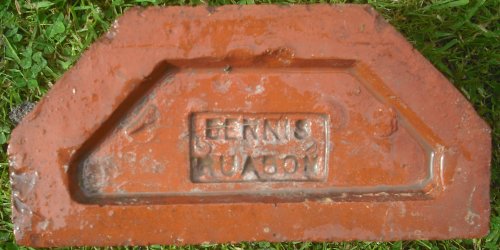

The entrance to J.C.Edwards works near Ruabon - the rest of the plant has been demolished.

Found in Worksop by Martyn Fretwell.

Photo by Karen Schindler.


Found by Gordon Hull at the estate cottage of the Cwm Elan mine, in the upper Elan Valley in Powys. The cottage was built after the valley was flooded in the 1890's.

Photo by Steven Taylor.

The company of J. C. Edwards (Ruabon) Ltd, was based in Ruabon, Denbighshire, and was active from 1903 to 1956 as a brick, tile and terracotta manufacturer from its works at Tref-y-Nant, Acrefair, Albert Works, Rhosllannerchrugog, and Pen-y-bont, Newbridge, Denbighshire. James Coster Edwards (1828-1896) founded the company; it was sold in 1956.

Photo taken at a reclamation yard in Tarvin, Cheshire by Martyn
Fretwell

Photo by Ray Martin.

Found at the Cambrian Railway Society's Weston Wharf site Oswestry
by Mike Shaw.

Photo by Frank Lawson.

Photo by Jason Stott.

The use of 'England' by the Welsh brickmaker must have been for marketing purposes. Photo by Hamish Fenton.

Photo by John Elliott.

A small brickworks in the village of Rhosllanerchrugog. Operating as early as 1860 and owned by a local builder. Later owned by Messrs Kaye & Hirst, the works had disappeared by the end of the 19th Century. Photo by David Kitching.

Found on the seashore in Crosby, Merseyside. The Garth Brickworks at Trevor was a small site when taken over by Charles Mason around 1870. Following turbulent fortunes, he left the works in 1889 to take over running the brickyard at the Vron Colliery in Coedpoeth.
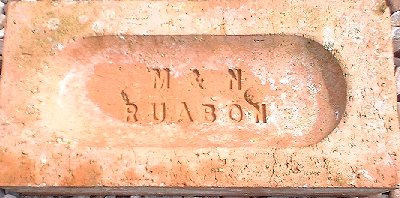



"Monk & Newell" was situated on the east side of the Ruabon-Wrexham road. Monk & Newell operated their brickworks at Ruabon from 1883 until 1919 when the works was sold to T D Stubbs, who then traded as the North Wales Brick & Tile Company (NWB & T CO LTD) and used the trade name Rubric. The brickworks closed in 1930 and the site was later used for housing ('Newell Drive') and the adjacent flooded claypit (Monk's Pool) is now used by a local angling club.

Photo by Tim Lawton.

Photo by Hamish Fenton.

Photo by Andrew Morley.
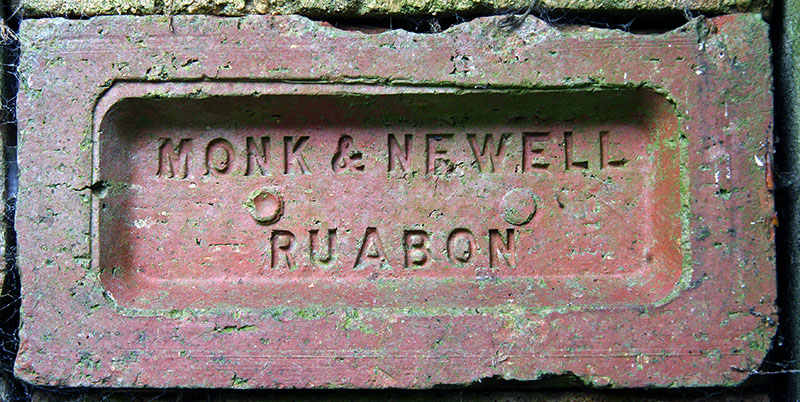
Photo by David Kitching.


Photos by Frank Lawson.

This is believed to be an early example from this brickworks. The R has been stamped onto the brick after it came from the machine. Found in a reclamation yard amongst a lot of other Monk & Newell and Dennis bricks. Photo by Martyn Fretwell.

From the Imperial Hotel at Douglas, Isle of Man, which was built in the 1890s. Photo and information from Nigel Megson.

Found by Becky Philo on Crosby Beach. Photo by Jud Hirst.

Photo by Ian Williams.

Photo by Frank Lawson.

The largest of the Rhos brickworks, it was originally a colliery and ironworks until it became the North Wales Coal & Fireclay Co. around 1860. It later became the Pant Coal, Brick & Fireclay Co. and was eventually taken over by the industrialist Henry Dennis in 1886 when he formed the Ruabon Glazed Brick and Fireclay Co Ltd. He turned production over to glazed firebricks and made it one of Britain's most important producers of this product, Gwersyllt Silica Brick Co. bought the works in 1921 after glazed bricks went out of fashion. Closure finally came in 1971.

Photos by David Kitching.

Although only a small and short lived country brickyard north of Acrefair, the works was connected to the G. W. R. by a branch line. Owned by various parties during its lifetime, it was derelict by 1900. Photo by David Kitching.

From the village of Ponciau between Ruabon and Rhosllanerchrugog. Poor quality clay beds never allowed this brickworks to develop much. Begun in 1866, it finally became a pottery works owned by a member of the Dennis family. It had ceased production by the end of the 19th Century.
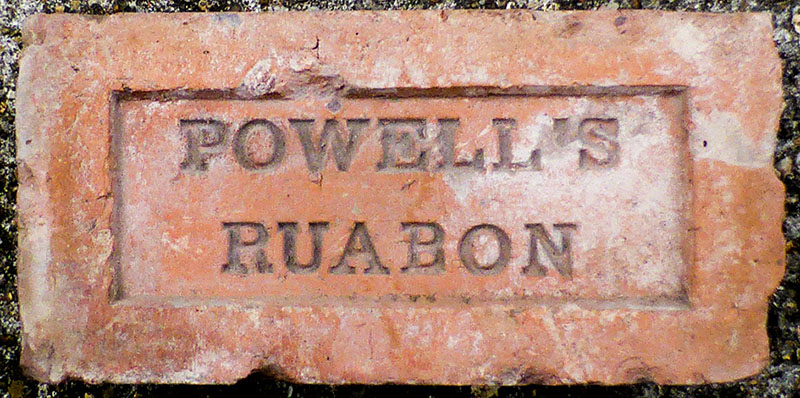
Photo by Martyn Fretwell.

Part of the Andrew Connelly collection





Powell Brothers opened their works at Llwyneinion in 1891 and in 1924 ownership passed to the Llwyneinion Shale Brick Co. After 1929 until closure in 1957 it was owned by the Hartley Family who also had the Ruby Works at Rhydymwyn. Photos and information by David Kitching.

Roberts and Maginnes.




Sandrust was a registered trade mark of the company in the 1930s. Photos by David Kitching.
The 'Ruabon Brick & Terra Cotta Ltd." or "Jenks' Terracotta Works" (or "Gwaith Jinks") was situated on the west side of the Ruabon-Wrexham road (off Tatham Road) but with its original clay pit to the east of the Ruabon-Wrexham road, separated from the Monk & Newell clay pit by the Afon Goch. Founded by the Hague family of the Gardden in about 1883 and managed by Henry Jenks. It was taken over by Dennis' in the 1960s but closed in the mid 1970s.

Photo by Frank Lawson.

Possibly a very old Ruabon example, found in Corris by Martyn
Fretwell.
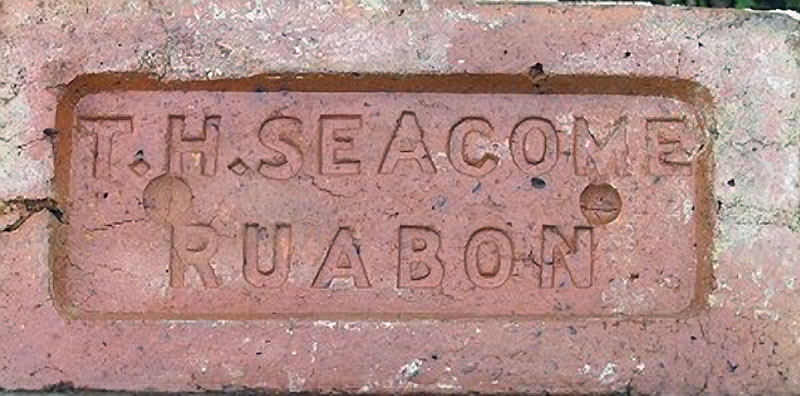
The 1881 census for Wem describes the occupants of a house called
Bodwyn in Noble St. as 'Thomas Harrison Seacombe, aged 51, a
brickmaker employing 46 men and 22 boys'. His wife Francis, two
daughters. A governess and two servants were also resident.
Thomas Seacome founded his brickworks at Delph Quarry, Acrefair
near Ruabon in 1868. The brickworks were taken over by Wyndham and
Phillips in 1883. Following closure in 1995 the site became an
opencast coal and clay quarry.
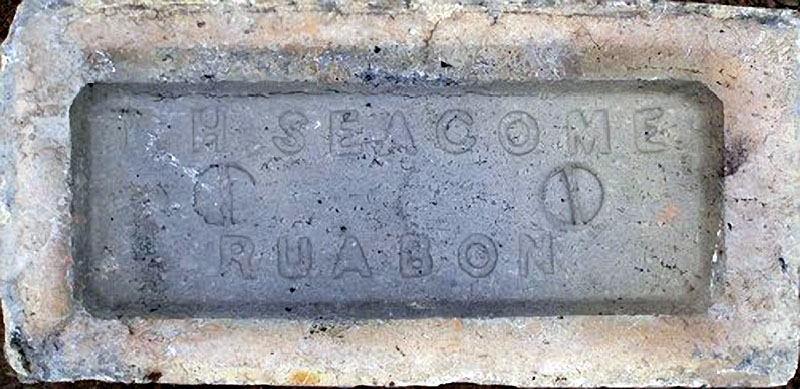

Photos by courtesy of the Frank Lawson collection.

Photo by David Kitching.


Wyndham & Phillips Ltd., The Delph Brick & Fire-Clay Works, Ruabon. The Delph Clayworks was established around 1870. Originally It was owned by Thomas Seacombe and then in around 1883 by Henry Wyndham. A partnership was formed with Mr R T Phillips who formed a limited company in 1906 after taking over the business entirely at the end of the partnership with Henry Wyndham.
The works manufactured bricks and chimney pots from the nearby deposits of fireclay situated above the works, on the Pen-y-cae road. Wyndham & Phillips produced salt-glazed fireclay sanitary pipes and moulded fittings for export all over the world, including Cairo, Port Elizabeth and Buenos Aires.A simple gravity tramway truck system conveyed the clay to the works but by 1928 the best clays were worked out. At its peak, there were 18 kilns at the Delph Works with about 100 men including press-men, moulders, bricklayers, carpenters, blacksmiths and engineers. After closure in 1955 it became an opencast coal and clay quarry, using the biggest mechanical excavator then to be found in Britain. Photos by Frank Lawson.



Spotted by Jonathan in Llandudno.

Photo by David Kitching.

Wynnstay Colliery Limited. This colliery near Acrefair was part of a vast and complicated industrial holding, including brickworks and ironworks in the district. The colliery became one of the most prestigious in the district and was visited by Princess Alexandra.

Wynnstay Estate brickyard. This brickworks served the estate of Wynnstay Hall, home of Sir Watkin Williams-Wynn (1820 - 1885) the 5th Baronet. Established before 1855 the brickworks seems to have closed in 1914.The Wynnstay Estate timber yard now occupies the site which had two kilns. Photo by Catherine James.